M
Leave a Legacy of Giving
You can support our mission of changing lives by saving sight in multiple ways!
Saving Sight is pleased to welcome three new people to its Board of Directors for the 2018-2019 fiscal year (July 1 – June 30). Welcome VCC Pat Scott, IPCC Larry Boettcher, and PDG Roger Tiemann! Board members are key to the organization’s success. They actively participate in long-range planning and monitor the organization’s financial health and overall performance. As highly visible members of their communities, the board members also enhance Saving Sight’s public standing by sharing the mission, accomplishments, and goals with Lions clubs, the general public, and other partner organizations. As Lion board members, these individuals also keep their districts informed about Saving Sight. “Our board members provide crucial oversight that enables us to change more lives by saving sight through their engagement and support,” said Tony Bavuso, chief executive officer.
Saving Sight also expresses its gratitude to three individuals who retired from the board of directors on June 30, 2018. “Thank you to PDG Sandy McCann (served 3 years), PDG Lion John Reese (served 6 years), and Dr. Dan Schoenleber (served 6 years) for your service and the valuable leadership you provided over the past few years,” added Bavuso.
At the June Board of Directors meeting, the board elected its 2018-2019 leadership team.
These board members were elected to leadership roles for the new fiscal year:
President: Lion Pat Martchink, MD-26 M2
Vice President: IPCC Larry Boettcher, MD-26 M4
Treasurer: Lion Mike Oldelehr, MD-26 M7
Secretary: Lion Cassidy Obermark, OD, MD-26 M1
Congratulations to the leadership team. To see the full listing of Saving Sight’s board of directors, visit our Leadership Page.
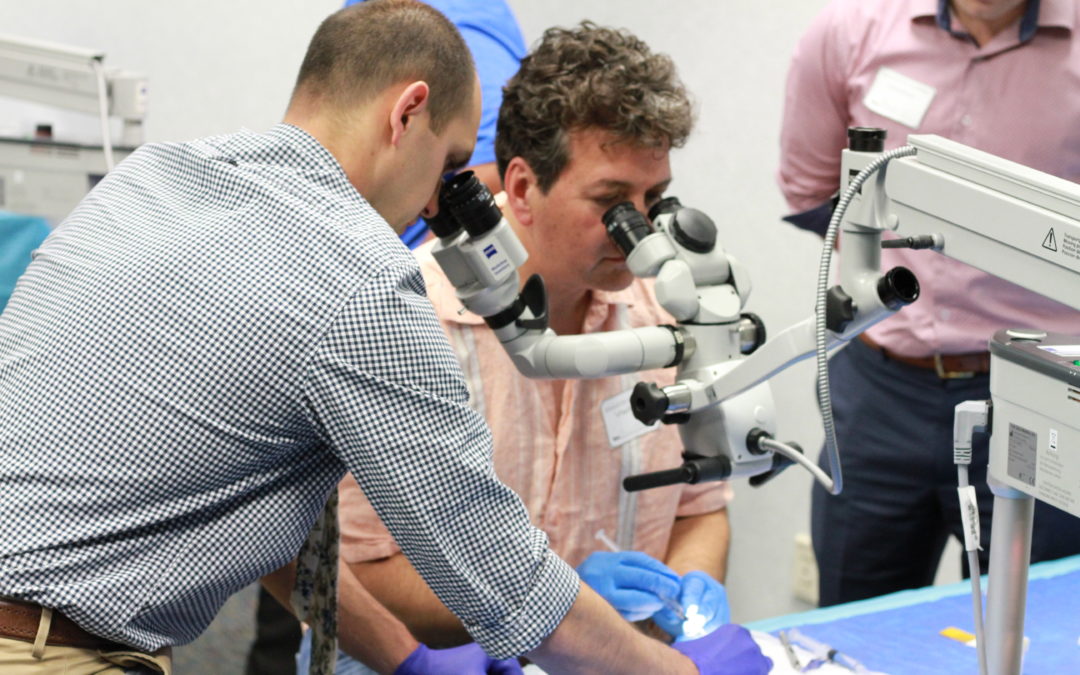
Join Saving Sight in St. Louis on June 2nd for a comprehensive DMEK wet lab with experienced surgeons. The day will include a full morning of didactics and videos followed by a live demonstration of the procedure and the wet lab. Lecturers will cover the DMEK procedure from start to finish and work with you one-on-one to practice the technique. The final day to register is May 17!
Bausch & Lomb Surgical
3365 Tree Court Industrial Blvd, St. Louis, MO 63122
Mark A. Greiner, MD, Instructor & Lab Facilitator

Mark A. Greiner, MD, University of Iowa Carver College of Medicine
Dr. Mark Greiner is Associate Medical Director and Assistant Professor of Ophthalmology and Visual Sciences at the University of Iowa Carver College of Medicine.
After completing his medical degree and residency in ophthalmology at the University of California at Davis, he completed his fellowship training in Cornea and External Diseases with Mark Terry at Devers Eye Institute in Portland, Oregon. Since joining the faculty at Iowa, Dr. Greiner has pursued his interests in eye banking and endothelial keratoplasty. He currently serves as Associate Medical Director at the Iowa Lions Eye Bank and is a clinician-scientist with a translational research laboratory that focuses on corneal endothelial cell metabolic function and keratoplasty outcomes. Dr. Greiner authored many publications including chapter 131, Surgical Technique of DMEK in the 4th edition of Cornea: Fundamentals, Diagnosis and Management. Read more about Dr. Greiner’s background here.
Shahzad I. Mian, MD, Instructor & Lab Facilitator

Shazad I. Mian, MD, University of Michigan Medical School
Shahzad I. Mian, M.D., is the Terry J. Bergstrom Collegiate Professor for Resident Education in Ophthalmology and Visual Sciences. He also serves the Department as Associate Chair for Education and is an associate professor of ophthalmology and visual sciences the University of Michigan Medical School. Dr. Mian earned his medical degree in 1996 from the Emory University School of Medicine. He then completed a residency at the Wills Eye Hospital of Thomas Jefferson University in Philadelphia. From 2000-02, he was a fellow in cornea and refractive surgery at Harvard Medical School, Massachusetts Eye and Ear Infirmary. He joined the U-M faculty in 2002 as a clinical lecturer in ophthalmology and visual sciences, and he was promoted to associate professor of ophthalmology and visual sciences in 2010. He has served on the board of directors and as a medical director of the Midwest Eye-Banks and currently serves as cornea editor for the Ophthalmic News and Education Network, board member of the Cornea Society, member of the Program Director’s Council and councillor for the American Academy of Ophthalmology. Read more about Dr. Mian’s background here.
Geoffrey Hill, MD, Lab Facilitator

Geoffrey Hill, MD, Hill Vision Services
Geoffrey Hill, MD is a cornea specialist and partner at Hill Vision Services in St. Louis, Missouri. Dr. Hill received his undergraduate degree in Biology from the University of Missouri Columbia and received his medical doctorate from St. Louis University. He completed his ophthalmology residency at the John H. Stroger Jr. Hospital of Cook County in Chicago, Il and a fellowship in Cornea and Ocular Surface Disease at the University of Texas Southwestern in Dallas. Dr. Hill is a member of the American Academy of Ophthalmology and the American Society of Cataract and Refractive Surgeons. Read more about Dr. Hill’s background here.

660 Maryville Centre Drive
St. Louis, MO 63141

1335 S. Lindbergh Blvd.
St. Louis, MO 631311
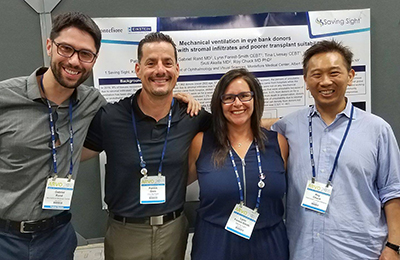
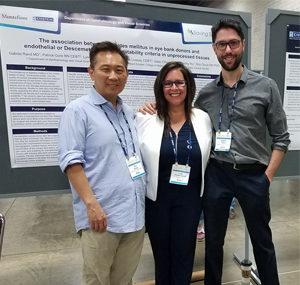
Dr. Roy Chuck, Lynn Forest-Smith and Dr. Gabriel Rand at ARVO 2018
With the rise in diabetes, discussion over the quality of corneal transplant tissue from diabetic donors in US eye banks is of concern. According to new research presented this week at the 2018 Annual Meeting of the Association for Research in Vision and Ophthalmology in Honolulu, scientists are one step closer to proving the suitability of the tissue from diabetic donors.
Through the study, a retrospective analysis was conducted to determine if corneas from diabetic donors were more likely to be marked unsuitable for surgical use based upon poor Descemet membrane (DM) or endothelial cell ratings.
This project, led by Gabriel Rand, MD, resident at the Albert Einstein College of Medicine Department of Ophthalmology and Visual Sciences, found that the presence of diabetes was not significantly associated with reduced transplant suitability. This study was the first in collaboration with Kansas City-based nonprofit Saving Sight’s donor data and is consistent with previous studies to support the continued preservation of the diabetic donor pool.
“Many cornea transplant surgeons are apprehensive about using grafts from diabetic donors because they believe the tissue to be of poorer quality. We analyzed the Saving Sight database and found that diabetes was not associated with differences in tissue quality across a number of eye bank suitability criteria. The research supports greater transplant utilization of tissue from diabetic donors,” said Dr. Rand.
Saving Sight Chief Business Development Officer Patrick Gore, RN, CEBT, Director of Business Development Lynn Forest-Smith, and Chief Operating Officer Tina Livesay were co-authors on the study. As an eye bank that facilitates eye donation for transplant and research, Gore said Saving Sight is proud to support this project and to work in collaboration with Montefiore and Drs. Rand, Chocron, Hu, Akella and Chuck.

Dr. Gabriel Rand, Patrick Gore, Lynn Forest-Smith and Dr. Roy Chuck at ARVO 2018
“We appreciate partnering with such dynamic collaborators to further ophthalmic research. To paraphrase the great Helen Keller, we believe that working together we can always achieve so much more,” said Gore.
In addition to the diabetes study, the team also presented their findings on mechanical ventilation in eye bank donors and its association with poorer corneal transplant suitability at ARVO 2018.
These studies continue to advance innovation and research in corneal transplantation through collaboration between eye banks, medical centers, and researchers.
“Eye banks have traditionally had the essential role of supplying donor tissues that enable people to see,” said Dr. Rand. “Working with Dr. Chuck and Saving Sight has been an incredible opportunity for me to understand how in addition to this role, eye banks can also advance academic research in the field of ophthalmology.”
Abstracts:
Diabetes mellitus in eye bank donors does not impact corneal transplant suitability
Authors: Gabriel Rand MD, Isaac Chocron MD, Jimmy Hu MD, Patrick Gore RN CEBT, Lynn Forest-Smith CEBT, Tina Livesay CEBT, Roy Chuck MD PhD
Mechanical ventilation in eye bank donors is associated with poorer corneal transplant suitability
Authors: Patrick Gore RN CEBT, Gabriel Rand MD, Isaac Chocron MD, Lynn Forest-Smith CEBT, Tina Livesay CEBT, Sruti Akella MD, Roy Chuck MD PhD
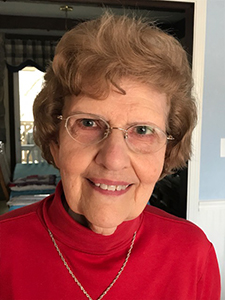
 Some of Rosalia’s fondest memories of her mother revolve around reading. “Mother was a reader,” says Rosalia. “She always said a day she didn’t get to read anything was hardly worth it. She would sit down 30 minutes a day to read. It was important to her, and she taught her kids that.”
Some of Rosalia’s fondest memories of her mother revolve around reading. “Mother was a reader,” says Rosalia. “She always said a day she didn’t get to read anything was hardly worth it. She would sit down 30 minutes a day to read. It was important to her, and she taught her kids that.”
For as long as Rosalia remembers, the love of reading and learning have been important to her. “When I was in third grade, I read every book in the third grade library,” she recalls, amused. “I’ve been a reader from a long way back. I’ve always joked if I couldn’t find anything to read, I would read the labels on the soup can.”
This love of learning led Rosalia to become a home economics teacher and she also was certified to teach English. It was while teaching she met her husband.
When the hereditary disease Fuchs’ dystrophy threatened Rosalia’s ability to see clearly in retirement, she received two corneal transplants in the span of two years thanks to the generous gift of sight from eye donors. “I just feel so fortunate and blessed because this changed my life so completely,” she says. “I can’t express how grateful I am to the donors for my gift of sight.”
Rosalia is no stranger to Fuchs’ dystrophy and cornea transplantation. Her father underwent two full corneal transplants and her sister has also received two transplants so she knew what to expect. “You don’t just wake up one morning and everything is so cloudy you can’t see,” she says, “But it’s gradual and you try to compensate as long as possible.” As her eyesight diminished, Rosalia began having to read and sew using hand held magnifying glasses they kept in every room in their home. She also was the main driver in the family at the time and needed her vision corrected to be able to continue taking her husband to his dialysis appointments.
Thanks to her transplants, Rosalia can see clearly in her daily activities and while spending time with her 3 children and 5 grandchildren. “It is so wonderful that now I can pick up almost anything and read the fine print. It’s such a blessing.”
Rosalia has long carried the organ donor designation on the back of her driver’s license and encourages others to join the registry as well. “I strongly felt that was important, and having had a parent who had been through it I understand it even more,” she says. “When you no longer need it, if someone else can see or receive a heart, lung or kidney why not donate to help them? Because of my husband’s need for dialysis, I know how long the list is for getting a kidney, so I felt very blessed to be able to receive a cornea transplant,” says Rosalia.
You can help others when you join the national organ, eye and tissue donor registry at www.registerme.org. And be sure to discuss your decision with family members so they know what your wishes are regarding donation.
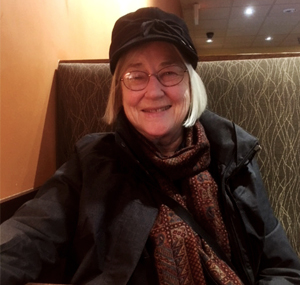

Thanks to the gift of sight, Anita was able to receive a corneal transplant in hopes of restoring her vision.
Not long ago, diminishing sight threatened to take away Anita’s ability to read and see well enough to sew her quilts. An active and proud grandmother, she and her husband recently retired to Columbia to be closer to their children and grandchildren. “We are loving being close enough to be part of their lives as they are growing up,” says Anita. Though they now live in mid-Missouri, Anita is a proud Vermonter through and through and they enjoy going back to visit every summer.
Anita’s journey with sight started with a cataract operation that did not have the outcome of clearing her vision. Since the cataract surgery, she has had 3 corneal transplants in hopes of restoring her vision in her right eye. “My eye appears to have been damaged by a few bouts of Bell’s Palsy,” says Anita. “My eye wouldn’t blink and during that time most likely caused damage to my eye as it wasn’t closing properly. The eye wasn’t shutting and it might have dried out the bottom of the first transplant.”
Anita’s most recent corneal transplant is working well so far. “With this one they have closed my eye a little bit from the corner to help keep it a tight close so my eye won’t get dried out at night.” Anita has seen progress and her vision keeps getting better and better.
“Following my first surgery, I’ve had Dr. Fraunfelder. He’s been great and I’ve enjoyed working with him,” says Anita. Dr. Frederick Fraunfelder is the director of University of Missouri Health Care’s Mason Eye Institute and chair of the Department of Ophthalmology at the MU School of Medicine.
Sending Thanks through Correspondence
Anita chose to write a letter to her donor family through Saving Sight’s Correspondence Program. “If someone in my family became an eye or organ donor I would be most appreciative to get a note from the recipient,” says Anita. “This generous decision that their loved one made resulted in my receiving a whole cornea transplant in a procedure aimed at restoring vision in my right eye. I thank them from the bottom of my heart. This generosity will never be forgotten.”
Anita is grateful to her donor family and is a registered organ, eye and tissue donor herself.
You can save and enhance lives when you join the national registry at registerme.org.